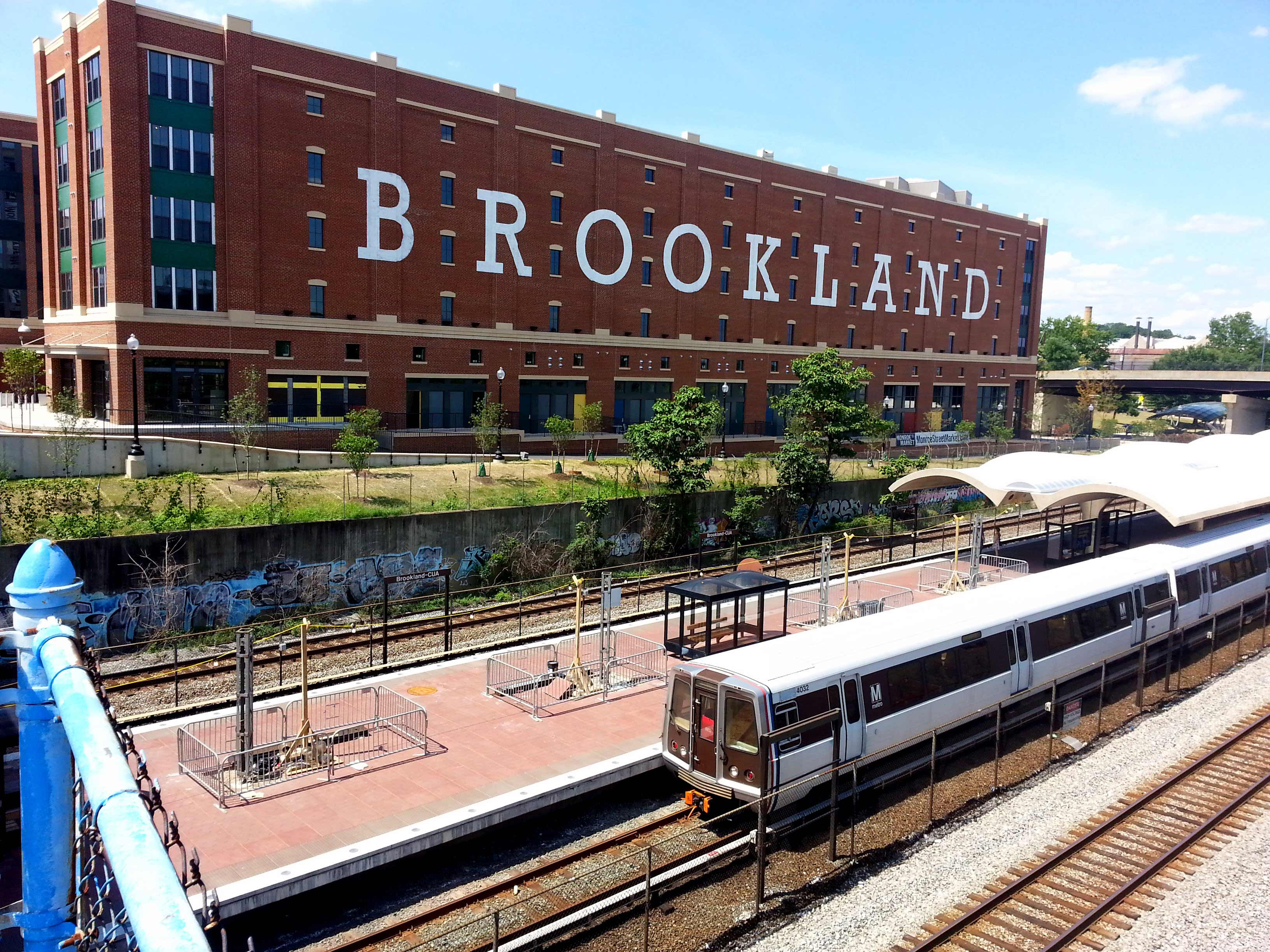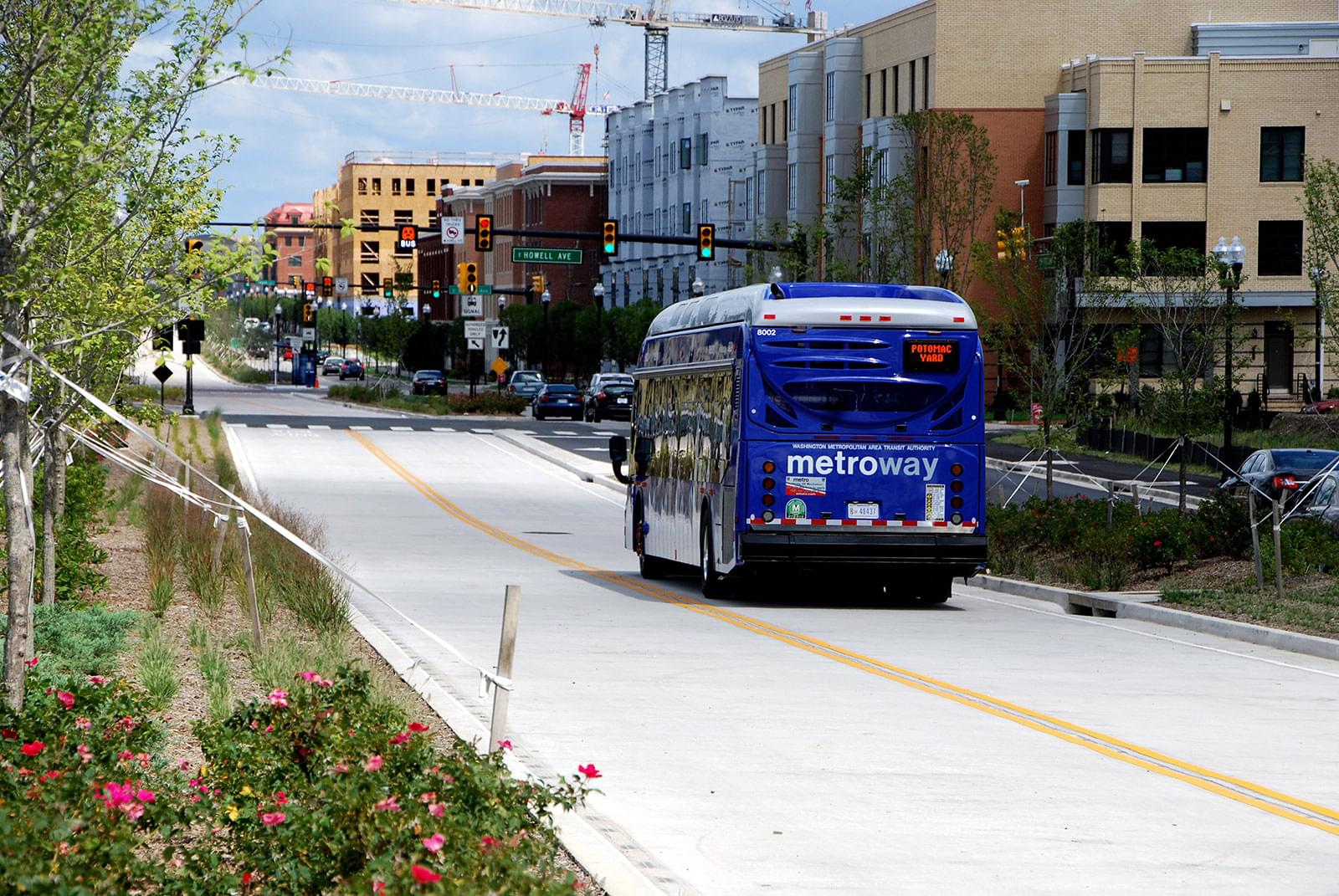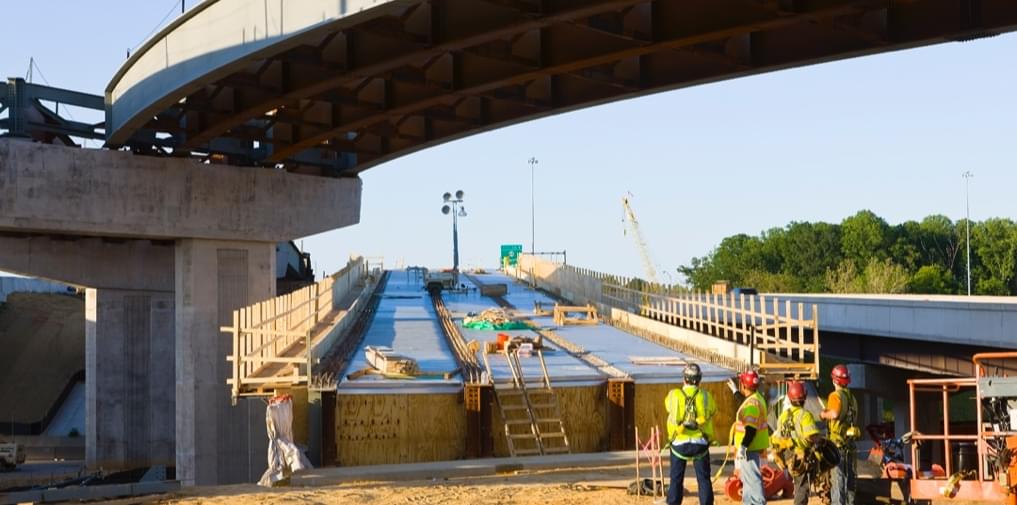Action 5.1
Increase Density and Ensure Inclusive Development in Areas Near Rapid Transit Corridors

What
Since personal vehicle ownership may be cost-prohibitive for low-income households, a transportation system lacking affordable alternatives to driving can restrict residents’ access to opportunity and their ability to fully contribute to the region’s economic growth. A successful approach is to maximize dense, mixed-use, market-rate, and affordable development near regional transit corridors. This can improve job accessibility, significantly decrease the length of unemployment for workers, increase transit ridership, and increase the region’s supply of affordable housing. In addition, the household cost savings associated with lower transportation costs allow lower-income households to redirect that spending toward other necessities such as healthy food, education, or healthcare.1
Public and private partners can promote walkable, transit-friendly development, also known as “Transit-Oriented Development” (TOD). TOD communities offer a mix of residential, retail, office, and public spaces, covering a compact area that is an average 10-minute walk—or within a quarter-mile—to a transit stop.2 This dense, transit-rich development creates high-opportunity neighborhoods through increased access to jobs, education, health centers, and other essential destinations. Investment in TOD has been proven to provide significant benefits to both the regional economy and the disinvested communities surrounding transit hubs.
Regional leadership from elected officials and civic leaders is required for the Capital Region to maximize the potential benefits from TOD projects. The Partnership urges the region’s leaders both to boost equitable development near transit stations by encouraging increased densities and to invest in preserving and growing affordable housing near rapid transit.
Why
Successful TOD generally requires dense, mixed-use development near transit stops. This development pattern can support increased transit ridership and reduce roadway congestion by increasing the jobs, housing, and activity centers accessible by transit, walking, or bicycling.
Yet, TOD projects can have the unintended effect of pricing low- and middle-income consumers out of transit-rich areas. A study of 17 TOD projects in the U.S. found that consumers have a lifestyle preference for transit-oriented living, which drives up costs when supply is constrained.3 This is occurring in the U.S., with walkable, mixed-use developments demanding a 74 percent rental premium over less dense, car-centric developments.4
Regions that are intentional in their development policies can maximize development potential near rapid transit investments while also preserving and growing affordable housing options in these opportunity-rich areas. Zoning regulations that increase development densities near transit stops, improvements to biking and walking access to transit stops, targeted investment in equitable development and preservation, and collaborative plans for new or significantly enhanced transit corridors are tools that jurisdictions around the country use to support successful TOD projects.
TOD funds and TOD affordable housing zoning regulations can help preserve and expand affordable housing options. For new or significantly enhanced transit capacity projects (e.g., the Purple Line discussed below), agencies can leverage these tools by creating community preservation and improvement plans to mitigate displacement of low- and moderate-income households and existing businesses—often those who would most benefit from transit service—as a result of new TOD development near the transit corridor. The Capital Region’s public agencies currently conduct community preservation and improvement plans on an ad hoc basis.
Benefits
Areas within the Capital Region already experience congestion relief and reduced demand on the roadway network as a result of successful TOD projects. In part due to policies that allow for dense transit-area development, between 1996 and 2012, Arlington County significantly reduced traffic across most major arterial roads despite large increases in population and economic activity.5 Montgomery County similarly focused growth in urban centers and maintained a relatively stable level of vehicle travel in the county from 2002 to 2012 despite an increase of 100,000 residents.6
Intentional preservation and expansion of affordable housing options in the TOD corridor enhance economic opportunities for low- and middle-income families. In a study of nine metropolitan areas, the better job accessibility provided by the connections to transit was found to significantly decrease the length of unemployment for certain lower-paid workers who had recently lost their jobs.7 In addition, the household cost savings associated with lower transportation costs allow lower-income households to redirect that spending toward other necessities such as healthy food, education, or healthcare. A study by the Illinois Housing Development Agency found that households in transit-rich neighborhoods saved an average of $3,000 per year in transportation costs compared to neighborhoods without transit access.8
Through extensive engagement with public, private, and community stakeholders, the Purple Line Corridor Coalition in Maryland established a Community Development Agreement that laid out both a vision for development along the new light rail line and strategies to achieve that vision. Though the agreement is not legally enforceable, its signatories are committed to achieving the shared vision outlined by the Coalition, which is important to holding all parties accountable to its long-term success. The Community Development Agreement identifies specific goals and actions to ensure the project achieves job, housing, and mobility benefits. For example, the agreement takes stock of the existing affordable housing along the corridor and calls for maintaining and improving the current stock, if necessary, by recommending legislation.9
In San Francisco, the Bay Area Transit-Oriented Affordable Housing (TOAH) Fund leveraged an initial $10 million in seed capital from the region’s metropolitan planning organization (MPO)—the Metropolitan Transportation Commission (MTC)—to raise an additional $40 million from private, non-profit, and philanthropic sources.10 The TOAH Fund can award funds to development projects located within a half-mile of rapid transit service and that include affordable housing or other community services, such as child care centers, fresh food markets, and health clinics.11 In the first three years of operation, the TOAH Fund deployed over $30 million in capital—creating nearly 900 affordable housing units and expanding community-serving retail near rapid transit stops.12 In 2015, MTC further capitalized the Fund with an additional $10 million.13
In Seattle, the city’s housing authority allows developers to build at higher densities on sites near transit stations if the development meets mixed-income housing requirements.14 As a result, the city’s Yesler Terrace redevelopment is replacing 561 public housing units for families earning no more than 30 percent of the area median income and creating up to 1,100 additional low-income units.15 The project will also include 1,200 to 3,200 market-rate homes.16
Barriers
Like most areas of the country, the Capital Region’s transit investments are funded at the regional or state level, but are economically impacted by zoning regulations determined at the local level. In many instances, Capital Region development projects face opposition from residents who want to maintain the exclusivity of the area by keeping TODs and transit-dependent populations outside of the neighborhood. This real or perceived opposition further disincentivizes development and pushes development toward lower-income areas of the region where residents would benefit from the investment but are more likely to be unable to afford the increased costs that come with the development. It also can increase the cost for transit service by lowering ridership. For example, the Washington Metropolitan Area Transit Authority (WMATA) estimates a loss of 200 trips per day and $121,500 in annual fare revenue foregone due to the District’s decision to reduce the size of a TOD development project near the Rhode Island metro station by nearly 200 housing units and 50,000 square feet of retail space.17
Next moves
Currently, TOD is underutilized along the Virginia Railway Express (VRE) and Maryland Area Regional Commuter (MARC) commuter rail corridors in the Baltimore and Richmond regions as well as many of the eastern stations in the Washington metro area. However, it is a dominant development pattern in the District and many stations in Montgomery County and Northern Virginia. The Capital Region should maximize development in TOD areas through zoning changes, improving pedestrian and bicycle access to transit stops, and intentionally focusing on preserving and growing affordable housing near transit stops.
Next moves are:
- Local governments, with support from the region’s MPOs and transit agencies, should conduct zoning and accessibility studies for each rail and high-frequency transit stop to maximize density, affordable housing, and ridership potential
- Maryland, the District, Virginia, and local governments, should adopt economic development regulations that prioritize and incentivize inclusive TOD in locations with a mix of jobs, schooling, housing, and rapid transit connections
- State and local jurisdictions should adopt laws requiring corridor community preservation and improvement plans be completed no less than 12 months prior to a new rapid transit corridor project opening
- The Capital Region’s public and private employers should prioritize multimodal access as a key factor in future job site selections—and public agencies should incentivize this development pattern
- Maryland, the District, and Virginia—in partnership with MPOs and local jurisdictions—should use public funding to attract private resources to capitalize a regional Equitable Access TOD Fund
Costs
The regional and local economic benefits—including increased employment, property and sales tax revenue, and increased transit ridership—from inclusive, transit-oriented growth are expected to exceed the costs associated with changing zoning requirements and developing studies and plans.
Citations:
- Hersey, John and Michael A. Spotts. Promoting Opportunity through Equitable Transit-Oriented Development (eTOD): Making the Case. Enterprise Community Partners, April 2015.
- Transit-oriented development is “a mixed-use community within an average 2,000-foot (or 10-minute) walking distance of a transit stop and core commercial area. TODs mix residential, retail, office, open space, and public uses in a walkable environment, making it convenient for residents and employees to travel by transit, bicycle, foot, or car.”
Calthorpe, Peter. The Next American Metropolis: Ecology, Community, and the American Dream. Princeton: Princeton Architectural Press, 1993.
Hess, Daniel Baldwin and Peter A. Lombardi. “Policy Support for and Barriers to Transit-Oriented Development in the Inner City: Literature Review.” Transportation Research Record: Journal of the Transportation Research Board, Volume 1887. https://doi.org/10.3141/1887-04.
- National Academies of Sciences, Engineering, and Medicine. Effects of TOD on Housing, Parking, and Travel. Washington, DC: The National Academies Press, 2008. https://doi.org/10.17226/14179.
- Leinberger, Christopher B. and Michael Rodriguez. Foot Traffic Ahead: Ranking Walkable Urbanism in America’s Largest Metros. Smart Growth America, LOCUS, and The George Washington University School of Business, 2016. https://www.smartgrowthamerica.org/app/legacy/documents/foot-traffic-ahead-2016.pdf.
- “As Arlington booms, traffic drops.” Greater Greater Washington, June 2014. https://ggwash.org/view/35122/as-arlington-booms-traffic-drops.
- Mobility Assessment Report. Montgomery County, MD: Montgomery County (MD) Planning Department, April 2014. http://www.montgomeryplanningboard.org/agenda/2014/documents/MobilityAssessmentReport2014-DRAFT4-9-2014_000.pdf.
- According to analysis conducted by the National Bureau of Economic Research. Hersey, John K and Michael A. Spotts. Promoting Opportunity through Equitable Transit-Oriented Development (eTOD): Making the Case. Enterprise, April 2015.
- Ibid.
- “Pathways to Opportunity: Purple Line Corridor Action Plan.” Purple Line Corridor Coalition, Fall 2017. http://purplelinecorridor.org/wp-content/uploads/2017/10/PLCorridorActionPlan2017.pdf.
- Hersey, John K. and Michael A. Spotts. Promoting Opportunity through Equitable Transit-Oriented Development (eTOD): Barriers to Success and Best Practices for Implementation. Enterprise, October 2015.
- Ibid.
- “Metropolitan Transportation Commission Approves $10 Million New Investment in Bay Area Transit-Oriented Affordable Housing Fund.” Oakland, CA: Low Income Investment Fund, June 2015. http://www.liifund.org/news/post/metropolitan-transportation-commission-approves-10-million-new-investment-in-bay-area-transit-oriented-affordable-housing-fund/.
- Ibid.
- Hersey, John K and Michael A. Spotts. Promoting Opportunity through Equitable Transit-oriented Development (eTOD): Barriers to Success and Best Practices for Implementation. Enterprise, October 2015.
- “Redevelopment of Yesler Terrace.” Seattle Housing Authority. https://www.seattlehousing.org/about-us/redevelopment/redevelopment-of-yesler-terrace.
- Hersey, John K and Michael A. Spotts. Promoting Opportunity through Equitable Transit-oriented Development (eTOD): Barriers to Success and Best Practices for Implementation. Enterprise, October 2015.
- “WMATA’s Transit-Oriented Development Objectives.” Capital and Strategic Planning Committee Item III - B. WMATA, April 2018.https://www.wmata.com/about/board/meetings/board-pdfs/upload/3B-WMATA-TOD-Policy.pdf.
Expand to learn more
Collapse


